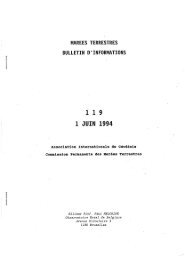marees terrestres bulletin d'informations - Université de la Polynésie ...
marees terrestres bulletin d'informations - Université de la Polynésie ...
marees terrestres bulletin d'informations - Université de la Polynésie ...
Create successful ePaper yourself
Turn your PDF publications into a flip-book with our unique Google optimized e-Paper software.
Figure 9<br />
Amplitu<strong>de</strong> spectra of different atmospheric effects from 2004/01/01 to 2007/12/31<br />
a) reduction 3D+2D , b) reduction 2D data , c) admittance factor<br />
en<strong>la</strong>rged<br />
d) reduction 3D+2D , e) reduction 2D data , f) admittance factor<br />
Fig.9a, b, c show the amplitu<strong>de</strong> spectra of the reductions using (3D+2D) data, 2D<br />
data, and an admittance factor respectively. The amplitu<strong>de</strong>s of the reduction<br />
based on 2D data have a 6% smaller value than the reduction based on (3D+2D)<br />
data and are 12% smaller than the reduction using an admittance factor on<br />
average in the spectral range between 0 and 2.0 CPD. To investigate in<br />
particu<strong>la</strong>r the range of long-period ti<strong>de</strong>s, the range between 0.0 and 0.18 CPD is<br />
en<strong>la</strong>rged (Fig.9d, e, f). The amplitu<strong>de</strong> of the reduction using 2D data is 1.3%<br />
smaller than the reduction using (3D+2D) and 12% smaller than the reduction<br />
using an admittance factor in this range on average. The amplitu<strong>de</strong> difference



